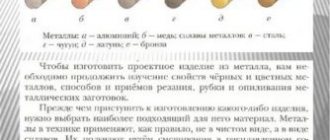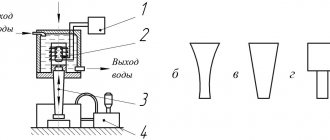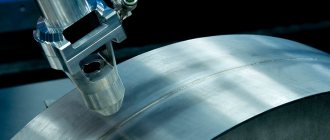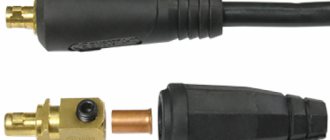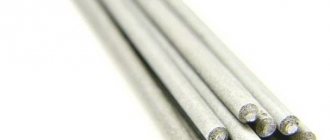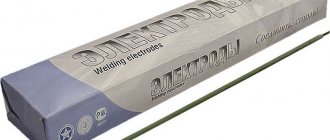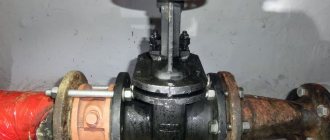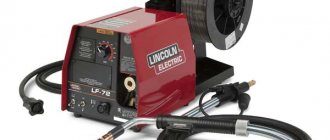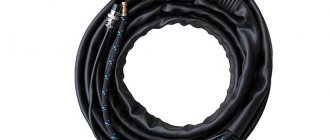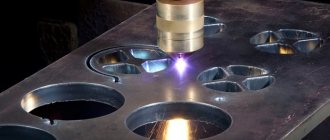What is the difference
When choosing, physical factors are taken into account:
- specific gravity;
- conductivity, including when heated;
- heat transfer coefficient;
- section.
Some factors are interconnected. For example, with an increase in the cross-section of an aluminum bus, heat transfer increases. This prevents cable deformation.
The disadvantages of aluminum are being corrected when modern technologies are used. For example, the strength of the Al 6101 alloy is higher than that of another type - Al 1350.
Properties of aluminum
Aluminum wiring bends easily, but breaks quickly.
Aluminum belongs to the category of light, chemically and biologically inert metals with a specific gravity of 2700 kg/m³. The material is safe for humans and the environment.
Advantages of aluminum:
- Affordable price. The price is determined by the lower melting point and lower production costs than other metals.
- Plastic. The wire bends well, maintaining its shape. The cores are given any configuration required for the job.
- Formation of a protective layer. After stripping, the metal surface is covered with a thin layer, which prevents its oxidation throughout its entire volume.
However, aluminum has the following disadvantages:
- High degree of resistance to electron flow. This causes the lines to heat up, which can cause the finishing materials to catch fire.
- High level of thermal expansion. Because of this, weakening of contact connections occurs. When lines with a high load are frequently switched on and off, the circuit becomes disconnected.
- Oxidation upon contact with air. The resulting film has poor conductivity, which causes the contacts to overheat and melt the insulation, and the ground line simply ceases to perform its function.
- Short service life. It does not exceed 30 years under average load.
Today, in accordance with GOST requirements, the use of aluminum is prohibited in the construction of residential buildings and engineering structures.
Copper wiring
The use of copper in electrical engineering has become widespread in the laying of communications, the design of electrical equipment - motors and as a transformer winding.
In some cases, the use of copper has no alternative due to its advantages.
Positive points
Not every electrician knows the values of the physical indicators of copper. But comparison with aluminum defines Cu's strengths:
- Conductivity that does not change due to time of use.
- Life time. At home, reliable operation is at least 50 years.
- Mechanical strength. The core will withstand bending or twisting up to 10-15 times.
- Easy to install. This advantage is associated with the ease of bending the cable when laying and fixing it in the connectors of sockets and switches.
It is worth remembering that copper has half the coefficient of thermal expansion compared to aluminum. This avoids deformation at the cable attachment point.
Negative features
Copper has not become widespread due to the high cost of Cu.
Copper is most often chosen when long-term wiring that can withstand heavy loads is required. As an alternative, it is recommended to make the power input from copper, and entrust the wiring for lighting to aluminum wires.
Electrical conductive products based on zinc alloy coated with copper sputtering are also on sale. Such a cable is slightly inferior in physical parameters to “pure” copper.
Another weakness of the red metal is its high specific gravity compared to Al. The multiplicity index is 1.85 to aluminum.
Pros and cons of copper cables
Copper is an excellent electrical conductor. And, perhaps, one of the best in the world. That is why today many homeowners who are building houses that will last for centuries, with a reserve of electricity consumption, prefer to do copper electrical wiring.
Yes, of course, such cables are significantly more expensive than aluminum ones. However, savings can be achieved in cross-section and installation. All other things being equal (the number of electricity consumers), you can choose a cable with a smaller cross-section, and the installation of electrical wiring from copper is much easier than from aluminum, because they are more flexible and durable, they can be twisted and bent without danger.
Unlike aluminum cables, copper home wiring can be easily upgraded without having to replace all the wires. If you need to increase the number of sockets or add more outlets, this is not a problem for copper wires. A circuit made of three-core copper wires 3x2.5 mm can support up to 10 sockets!
Aluminum wiring
The predominant use of light metal is typical for buildings built in the 60s and 70s of the twentieth century. The main criterion for choosing a silver metal is availability.
It is no coincidence that aluminum is called the winged metal. Everyone knows about its small specific gravity. But not only this determines the longevity of the use of this element in electrical engineering.
Advantages
The light weight of aluminum is used when laying high-voltage lines.
In a comparative aspect, the adopted proportion is that aluminum is 60% lighter than a copper busbar. Other advantages include:
- Low cost. Price plays a role when you consider the length of wiring in the house. The average cottage alone will require several kilometers of cable.
- Chemical resistance to oxidation. This feature is relevant given the closure of the rod with a plastic braid.
- Durability of exposed areas of aluminum. A protective film is formed on the surface of the metal, protecting the metal from external influences.
Al is also indispensable in the manufacture of contacts in lighting installations. Here metal replaced the used brass.
Flaws
The widespread use of aluminum did not occur due to significant disadvantages inherent in the metal:
- High resistivity and consequent tendency to heat up. Taking into account this property, it is not allowed to use a wire with a cross-section of less than 16 mm2.
The Al indicator is 0.0271 Ohm×mm2/m versus a similar characteristic for Cu – 0.0175 Ohm×mm2/m.
- Susceptibility to weakening of metal at contact points under heavy load. This is due to periodic heating and subsequent cooling of the attachment point.
- The problem of connecting sections of aluminum cable. The obstacle is a protective film on the surface.
- Fragility. Even without periodic heating, it is prone to fractures in places of bending. The resource is limited to 25-30 years.
“Winged” metal is not the best option when laying local networks. Its potential is the transmission of electricity over long distances.
What to look for when choosing wires
Diagram of copper and aluminum wires
When choosing between copper or aluminum for wiring, you need to take into account several criteria on which the efficiency of the electrical system depends.
You need to pay attention to the following nuances:
- Locations of sockets, lighting fixtures, packet and key switches. Based on the diagram, you can calculate the required cable footage.
- The total power of devices that will simultaneously be connected to the network. The result is an indicator of the maximum current load of the wires.
- Socket standard. They are adapted for connecting cores whose diameter does not exceed 2.5 mm. Current load and electrical conductivity of metals are correlated.
- Material cost. This parameter should be the last thing to focus on, since safety comes first.
We should not forget about such criteria as durability. Replacing communications is too expensive and time-consuming to carry out once every few years
Why you can’t connect old aluminum wiring and copper wires
During long-term operation, it becomes necessary to replace part of the electrical cable.
Also, during the repair, additional branching of the wiring is carried out in order to obtain additional power supply points. In this situation, it becomes necessary to join aluminum and copper elements.
The connection problem is due to two factors:
- Different resistivity of two metals. Even reliable twisting will be subject to external influences due to the greater thermal expansion of aluminum.
- Presence of oxide films. Both substances have such elements, but have different resistance. This further increases the temperature at the junction.
When operating under load, sparking appears at the point of contact, which prevents normal current conduction and creates conditions for a fire to occur.
Despite this situation, the connection of copper and aluminum is possible. For this purpose, special technological techniques are used:
- tinning using a soldering iron and solder - suitable for processing copper wire;
- lubricant - a special lubricant is used to prevent oxidation of the metal at the point of contact;
- use of metal adapters.
Among the representatives of the latter group the following devices are known:
- Nut-type connections. They are three parallel plates, where different wires are laid between two adjacent elements. The connection is placed in a plastic box.
- Terminal blocks. A common and inexpensive method. When laying wires on both sides, you should just avoid touching each other inside.
- Bolted connection. This method is distinguished by its simplicity of design and the inaccessibility of other methods. The two conductors are separated from each other by washers of suitable diameter, mounted on a bolt.
- Spring terminals. It is advisable to use the finished product during installation. The method is characterized by simplicity and reliability of fastening.
Any method allows you to avoid possible twisting of wires, and increases safety when using electrical energy.
Pros and cons of aluminum cables
The main advantage of aluminum cables is their low price. This is because their main raw material, aluminum, costs almost four times less than copper. The second advantage is ease. All other things being equal (sectional area), aluminum wires and cables weigh much lighter than copper ones.
However, in terms of electrical conductivity, aluminum cables are inferior to copper wires. According to research results, aluminum as an electrical conductor is almost 2 times inferior to copper. This is why many developers are forced to buy aluminum cables with a larger cross-section, with a margin.
Aluminum also gets very hot under load, and as a result of contact of such wires with the environment, an oxidation process occurs and an unpleasant light gray coating forms on the cables. Moreover, many professionals complain about aluminum's low tensile strength and axial force, i.e. such wires are less flexible.
Another disadvantage of aluminum is that when the temperature or load on the electrical network changes, the wire connections in the terminals may become loose. As a result, electrical contact deteriorates, resistance increases, and the area around the wires may begin to overheat.
Experts also advise keeping in mind that small cross-section aluminum cables may not be able to withstand a large number of connected electrical devices at once. Especially when it comes to energy-intensive devices, such as electric kettles, electric ovens, induction cookers. For this reason, if you plan to wire your home using aluminum cables, it is better to choose wires with a large cross-section (from 10 to 20 mm). Despite the fact that they will visually appear thicker than copper wires, they will weigh much lighter, which is a definite plus during installation.
It is also extremely important to ensure strong and safe contacts and connectors of such wires. It is best to use special clamps and fasteners, in particular spring contacts. It is also important to properly prepare the stripped end of the aluminum conductor. To do this, it is necessary to remove the oxide layer and lubricate the neutral with contact lubricant or Vaseline. After which you can attach the aluminum cable.
Should I replace the old aluminum wiring in my house with copper or not?
Laying copper wiring instead of aluminum cable should not be arranged as a “replacement for the sake of replacement.” This is not an easy task and it is financially expensive. Planned installation of a new wire is carried out in a number of situations:
- if the wire is damaged;
- when insulation is damaged due to aging;
- after a fire caused by a malfunction of electrical equipment, for example, due to a short circuit.
The use of copper will help further reduce the risk of accidents. You just need to study the branching diagram and select the wire of the required cross-section. The work is carried out under the supervision of an electrician.
Copper busbars have tangible advantages when used in power supply conditions for individual housing. The only insurmountable obstacle will be the cost, which is 3-4 times higher than the price of a similar aluminum product.
So which is better?
If you are building a house for yourself, plus plan to expand it in the future, copper cables will be the best choice. The high initial price will be compensated later by the greater potential for connecting electrical appliances and devices, as well as ease of upgrading. Copper wires are also much safer and easier to use than aluminum cables.
If savings are at the forefront, it is better to consider purchasing aluminum cables. However, keep in mind: they require more fiddling (more wires are needed), but they last less.
Did you find this article helpful? Please share it on social networks: Don't forget to bookmark the Nedvio website. We talk about construction, renovation, and country real estate in an interesting, useful and understandable way.
Properties of copper
Copper wiring is resistant to twisting and bending
. Copper is a heavy metal with a specific gravity of 8700 kg/m³. This indicator should be taken into account only when laying power lines with a limited safety margin of the supports. In everyday life it can be neglected. The material actively interacts with oxygen, forming an oxide - a patina, which can be seen on statues, fences and souvenirs.
The advantages of copper are as follows:
- Durability. If the line does not run outdoors, it can last 30-50 years depending on the humidity of the room.
- Strength. Copper is resistant to twisting and bending. A high-quality cable can be deformed up to 100 times without losing its performance characteristics.
- High conductivity. The metal allows electrons to pass through easily without being subject to heating or thermal expansion.
- Flexibility. The wiring easily takes the desired position, straightening after the load is removed. It is convenient to work with cables during the installation process.
The material also has disadvantages:
- High price. This is explained by the difficulties of ore mining and the costs of processing it. Melting the concentrate requires a large amount of energy, plus transportation costs.
- Oxidation when interacting with water and air. The resulting film impairs the conductivity of the contacts and contributes to their heating.
When choosing between aluminum or copper wiring, it is advisable to choose the second option, since it has more advantages than disadvantages.
